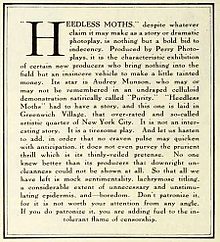Editorial

Editorial from a 1921 issue of Photoplay recommending that readers not see a film, which featured nude scenes
An editorial, leading article (US) or leader (UK), is an article written by the senior editorial staff or publisher of a newspaper, magazine, or any other written document, often unsigned. Australian and major United States newspapers, such as The New York Times[1] and The Boston Globe,[2] often classify editorials under the heading "opinion".
Illustrated editorials may appear in the form of editorial cartoons.[3]
Typically, a newspaper's editorial board evaluates which issues are important for their readership to know the newspaper's opinion on.[4]
Editorials are typically published on a dedicated page, called the editorial page, which often features letters to the editor from members of the public; the page opposite this page is called the op-ed page and frequently contains opinion pieces by writers not directly affiliated with the publication. However, a newspaper may choose to publish an editorial on the front page. In the English-language press, this occurs rarely and only on topics considered especially important; it is more common, however, in some European countries such as Spain, Italy, and France.[5]
Many newspapers publish their editorials without the name of the leader writer. Tom Clark, leader-writer for The Guardian, argues that it ensures that readers discuss the issue at hand rather than the author.[6] On the other hand, an editorial does reflect the position of a newspaper and the head of the newspaper, the editor, is known by name. Whilst the editor will often not write the editorial themselves, they maintain oversight and retain responsibility.[7]
When The Press, a New Zealand newspaper based in Christchurch, changed after 157 years from broadsheet to compact in 2018, they published a list of editorials where current thinking differs from opinions expressed at the time. The starkest example was their view on women's suffrage in New Zealand after the government gave women the vote in 1893, where the editorial proclaimed that women would "much prefer staying at home and attending to their household duties" than going to the polling booths.[8]
In the field of fashion publishing, the term has been adapted[by whom?] to refer to photo-editorials – features with often full-page photographs on a particular theme, designer, model or other single topic, with or (as in a photo-essay) without accompanying text.[9]
See also
- Column (periodical)
References
^ Staff (23 May 2012). "Opinion". The New York Times. Retrieved 23 May 2012..mw-parser-output cite.citation{font-style:inherit}.mw-parser-output q{quotes:"""""""'""'"}.mw-parser-output code.cs1-code{color:inherit;background:inherit;border:inherit;padding:inherit}.mw-parser-output .cs1-lock-free a{background:url("//upload.wikimedia.org/wikipedia/commons/thumb/6/65/Lock-green.svg/9px-Lock-green.svg.png")no-repeat;background-position:right .1em center}.mw-parser-output .cs1-lock-limited a,.mw-parser-output .cs1-lock-registration a{background:url("//upload.wikimedia.org/wikipedia/commons/thumb/d/d6/Lock-gray-alt-2.svg/9px-Lock-gray-alt-2.svg.png")no-repeat;background-position:right .1em center}.mw-parser-output .cs1-lock-subscription a{background:url("//upload.wikimedia.org/wikipedia/commons/thumb/a/aa/Lock-red-alt-2.svg/9px-Lock-red-alt-2.svg.png")no-repeat;background-position:right .1em center}.mw-parser-output .cs1-subscription,.mw-parser-output .cs1-registration{color:#555}.mw-parser-output .cs1-subscription span,.mw-parser-output .cs1-registration span{border-bottom:1px dotted;cursor:help}.mw-parser-output .cs1-hidden-error{display:none;font-size:100%}.mw-parser-output .cs1-visible-error{font-size:100%}.mw-parser-output .cs1-subscription,.mw-parser-output .cs1-registration,.mw-parser-output .cs1-format{font-size:95%}.mw-parser-output .cs1-kern-left,.mw-parser-output .cs1-kern-wl-left{padding-left:0.2em}.mw-parser-output .cs1-kern-right,.mw-parser-output .cs1-kern-wl-right{padding-right:0.2em}
^ Staff (23 May 2012). "Opinion". The Boston Globe. Retrieved 23 May 2012.
^ Staff (2012). "AAEC The Association of American Editorial Cartoonists". The Association of American Editorial Cartoonists. Retrieved 23 May 2012.
^ Passante, Christopher K. (2007). The Complete Idiot's Guide to Journalism – Editorials. Penguin. p. 28. ISBN 1-59257-670-2. Retrieved 21 February 2010.
^ Christie Silk (15 June 2009). "Front Page Editorials: a Stylist Change for the Future?". Editors' Weblog. World Editors' Forum. Retrieved 1 July 2011.
^ Clark, Tom (10 January 2011). "Why do editorials remain anonymous?". The Guardian. Retrieved 26 May 2018.
^ Crean, Mike (2011). First with the news: an illustrated history. Auckland: Random House. p. 97. ISBN 978 1 86979 562 7.
^ Matthews, Philip (28 April 2018). "Broadsheets and blunders: In defence of getting it wrong". The Press. Retrieved 26 May 2018.
^ "Various editorials". models.com. Retrieved 3 April 2012.
External links
 The dictionary definition of editorial at Wiktionary
The dictionary definition of editorial at Wiktionary- Editorial Writing Examples